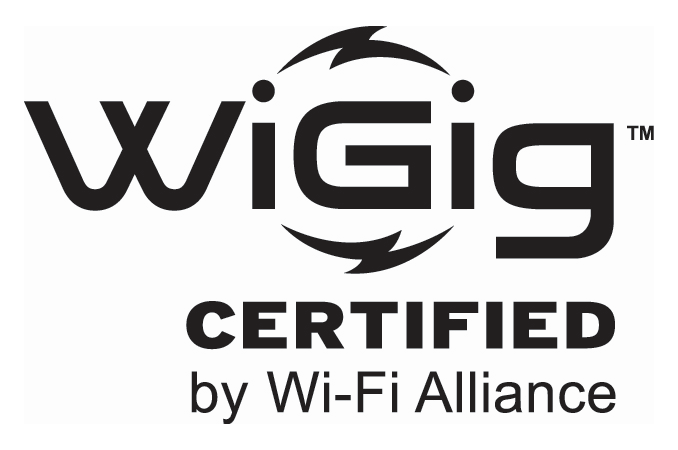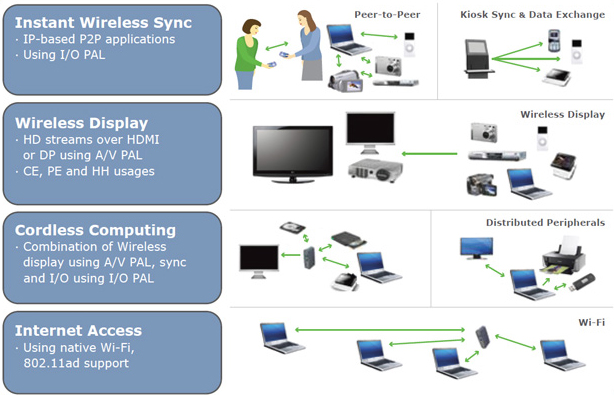Wi-Fi Alliance Begins to Certify 802.11ad WiGig Devices
by Anton Shilov on October 28, 2016 9:00 PM EST- Posted in
- Smartphones
- 802.11ad
- WiGig
- Wi-Fi
- Notebooks
- 60 GHz
- Wi-Fi Alliance

The Wi-Fi Alliance this week began to certify products featuring wireless modules compatible with the 802.11ad standard (aka WiGig). The certification will help to ensure that all WiGig-branded devices, which have been around for some time, can flawlessly operate with each other and deliver expected multi-gigabit performance over 60 GHz spectrum.
The WiGig technology (IEEE 802.11ad) is a short range communication standard that enables compatible devices to communicate at up to 7–8 Gb/s data rates and with minimal latencies, using the 60 GHz spectrum at distances of up to ten meters. Since 60 GHz signals cannot penetrate walls, the technology can be used to connect devices that are in direct line of sight. Given the limitation, WiGig cannot replace Wi-Fi or even Bluetooth, but it can enable devices like wireless docking stations, wireless AR/VR head-mounted displays, wireless high-performance storage devices, wireless displays, and others devices which need a lot of bandwidth.
To date, Intel and Qualcomm have released several tri-band chipsets that support the 2.4 GHz, 5 GHz and 60 GHz spectrums as well as Wi-Fi, Bluetooth and WiGig technologies. The Wi-Fi Alliance has already certified Intel’s Tri-Band Wireless 18260 (Maple Peak) and Qualcomm’s QCA9500 802.11ad-compatible chipsets as well as multiple devices that use them (including Dell’s Latitude E7450/70 as well as 802.11ad 60 GHz USB adapters from Peraso and Socionext). Going forward, the organization will certify other products, including smartphones and docking stations.
It should be noted that the start of WiGig certification on its own isn't going to be the catalyst to cause WiGig adoption to take off, but it will increase chipset developers', device makers', and end users' confidence in the standard. Designers of Wi-Fi chipsets and manufacturers of actual systems have been reluctant to adopt 802.11ad so far because the infrastructure is absent and so is demand, a classic chicken and egg dilemma. With the official certification process things will likely get a little better, mainly because of added confidence.
Meanwhile, analysts from ABI Research believe that 180 million of WiGig-enabled chipsets will ship inside smartphones already next year with 1.5 billion WiGig devices shipping in 2021.
Image Source: Blu Wireless Technology.
Source: Wi-Fi Alliance












50 Comments
View All Comments
mkozakewich - Monday, October 31, 2016 - link
A microwave oven throws out over 1000 watts of radiation, and it takes a minute or two to bring a cup of water up to boiling temperatures. If you strapped 500 routers together in some kind of horrible internet-inspired Hallowe'en mask, you'll notice a bunch of heat, which would be caused by the loss through all the other circuitry. I think each router is limited to about 1 watt, while they might display ten times that in heat through the other components.Lerianis - Sunday, October 30, 2016 - link
Why the big leap from 5Ghz to 60Ghz? Would not 6-59Ghz penetrate walls while allowing higher speeds?A5 - Sunday, October 30, 2016 - link
60GHz is the next major block of unlicensed spectrum after 5GHz.Meteor2 - Monday, October 31, 2016 - link
That's only an arbitrary human designation. I wonder what all that spectrum is being used for?Guspaz - Monday, October 31, 2016 - link
https://upload.wikimedia.org/wikipedia/commons/thu...ddarko - Sunday, October 30, 2016 - link
You shouldn't think of 802.11ad as a successor 802.11g/n/ac. The article refers to 802.11ad a "short range communication standard" and the chart puts a number on what that means: 10 meters or 32.8 feet. In other words, 802.11ad is a line-of-sight wireless standard. It really has no ability to penetrate walls. It's intended to replace wires in where the devices are physically close and need lots of bandwidth, for example, the video cords on monitors or televisions. Goodbye Displayport/HDMI, hello 802.11ad. Because of its limitations, 802.11ad isn't going to show up in mobile devices.Meteor2 - Monday, October 31, 2016 - link
Indeed, ax is the successor to ac, covered here on Anandtech earlier this week. There's also af, low-power/longer range (but slow) for IoT stuff.Meteor2 - Monday, October 31, 2016 - link
But you most certainly will see ad in mobile devices, to allow mobile docking. Think wireless Continuum, for example.The_Assimilator - Sunday, October 30, 2016 - link
8Gbps = 1GB/s = PCIe x16 3.0. Even if the quoted 8Gbps is full duplex and the actual rate is only 4Gbps both ways, that's still PCIe x8 3.0, which is still more than enough to allow every current graphics card in existence to perform at its best (difference between 3.0 x16 and x8 is ~1%, well within the margin of error). So the prospect of a "wireless" graphics card is there, depending on the latency.renovich31 - Sunday, October 30, 2016 - link
except that stating 8Gbps = 1GB/s = PCIe x16 3.0 is outrageously false, the PCIe x16 3.0 is rated at theorytically 16GB/s